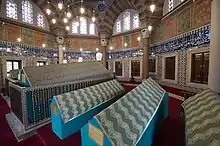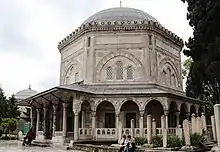Saliha Dilaşub Sultan
Saliha Dilaşub Sultan[1][a] (Ottoman Turkish: آشوب سلطان; "the devout one" and "queen bee's heart", died 4 December 1689), also known as Aşub Sultan or Aşube Sultan, was a consort of Ottoman Sultan Ibrahim and Valide Sultan to their son Suleiman II.[2]
| Saliha Dilaşub Sultan | |||||
|---|---|---|---|---|---|
 Sarcophagus of Saliha Dilaşub Sultan inside the Süleymaniye Mosque | |||||
| Valide Sultan of the Ottoman Empire | |||||
| Tenure | 8 November 1687 – 4 December 1689 | ||||
| Haseki Sultan of the Ottoman Empire (Imperial Consort) | |||||
| Tenure | 1642 – 12 August 1648 | ||||
| Predecessor | Ayşe Sultan | ||||
| Successor | Emetullah Rabia Gülnuş Sultan | ||||
| Born | Katarina c. 1627 Serbia | ||||
| Died | 4 December 1689 (aged 61–62) Edirne Palace, Edirne, Ottoman Empire | ||||
| Burial | |||||
| Spouse | Ibrahim | ||||
| Issue | Suleiman II | ||||
| |||||
| House | Ottoman (by marriage) | ||||
Life
She became the first concubine of Ibrahim after his rise at the throne and on 15 April 1642, gave birth to her only certain son, Şehzade Suleiman (the future Suleiman II) and she became the second Haseki after Turhan Sultan, mother of Mehmed, Ibrahim's firstson. During Ibrahim's reign her stipend consisted of 1,300 aspers a day.[3] He also gifted the incomes of Bolu Sanjak to her.[4] She was described as a simple-hearted woman of lively and cheerful character.[1]
After the deposition and death of Sultan Ibrahim in 1648, his eldest son, Mehmed IV, born by Turhan Sultan and only three months older than Suleiman, ascended the throne, after which Saliha Dilaşub settled in the Old Palace. This brought her thirty-nine years of imprisonment in the Old Palace.[5]
In 1651, the conflict Turhan Sultan and Kösem Sultan, mother of Ibrahim, could have changed her fortune in that she could become the Valide Sultan herself. Kösem was planning to kill her daughter-in-law and dethrone Mehmed with the help of some high officers in the yeniçeri corps, and to place Şehzade Suleiman on the throne, because Kösem thought that he and his mother were more controllable. However, Meleki Hatun warned Turhan, who managed to strangle her mother-in-law with the help of the eunuchs in the Harem in 1651. Saliha Dilaşub herself was spared from execution since she was not suspected in plotting against Turhan and Mehmed. [6][7]
In 1672–1673, she created an endowment at Istanbul.[8]
In 1687, Mehmed was deposed and the throne was overtaken by Suleiman, and Dilaşub became the next valide sultan.[9]
In July 1688, she followed her son to Edirne, reuniting with him after 39 years of separation, in which she was only allowed to see him twice a year on the occasion of festive celebrations. Her son honored her with a splendid settlement procession and the awarding of a large number of precious jewels, including a pair of pearl and diamond earrings.[10]
Death

She died in the Edirne Palace on 4 December 1689, having been ill and bedridden for a year. She was buried in the mausoleum of Suleiman the Magnificent in Süleymaniye Mosque, Istanbul.[10][5]
Issue
Together with Ibrahim, Saliha Dilaşub had a son:
- Suleiman II (Topkapı Palace, Istanbul, 15 April 1642 - Edirne Palace, Edirne, 22 June 1691, buried in Süleymaniye Mosque, Istanbul). Sultan of the Ottoman Empire.
It is not known for sure if she had other children, but, if Saliha Dilaşub was indeed Ibrahim's first concubine, she was probably at least the mother of his eldest daughter as well:
- Safiye Sultan (Istanbul, 1640 - ?). She married Baki Bey, son of the Grand Vizier Hezarpare Ahmed Paşah by his first wife.
In popular culture
- In the 2010 Turkish historical film Mahpeyker: Kösem Sultan, Saliha Dilaşub Sultan is portrayed by Turkish actress Gökcan Gökmen.[11]
- In the 2015 Turkish historical non-fiction TV series Muhteşem Yüzyıl: Kösem, Saliha Dilaşub Sultan is portrayed by Turkish actress Ece Güzel.[12]
See also
References
- Uluçay 2011, p. 96.
- Peirce, Leslie (1993). The Imperial Harem: Women and Sovereignty in the Ottoman Empire. Oxford University Press. p. 108. ISBN 0-19-508677-5.
- Thys-Şenocak, Lucienne (2006). Ottoman Women Builders: The Architectural Patronage of Hadice Turhan Sultan. Ashgate. p. 89. ISBN 978-0-754-63310-5.
- Resimli tarih mecmuasi. Iskit Yayinevi. 1956. p. 229.
- Uluçay 2011, p. 97.
- Akalin, Esin (October 11, 2016). Staging the Ottoman Turk: British Drama, 1656Ð1792. Columbia University Press. p. 225. ISBN 978-3-838-26919-1.
- Uluçay 2011, p. 96-7.
- Narodna biblioteka "Sv. sv. Kiril i Metodiĭ. Orientalski otdel, International Centre for Minority Studies and Intercultural Relations, Research Centre for Islamic History, Art, and Culture (2003). Inventory of Ottoman Turkish documents about Waqf preserved in the Oriental Department at the St. St. Cyril and Methodius National Library: Registers. Narodna biblioteka "Sv. sv. Kiril i Metodiĭ. pp. 116, 214.
{{cite book}}: CS1 maint: multiple names: authors list (link) - Sakaoğlu 2008, p. 349-50.
- Sakaoğlu 2008, p. 350.
- Mahpeyker - Kösem Sultan (2010), retrieved 2019-10-07
- Muhtesem Yüzyil: Kösem (TV Series 2015–2017) Poster Muhtesem Yüzyil: Kösem (2015–2017), retrieved 2019-10-07
- Sakaoğlu 2008, p. 349.
.svg.png.webp)